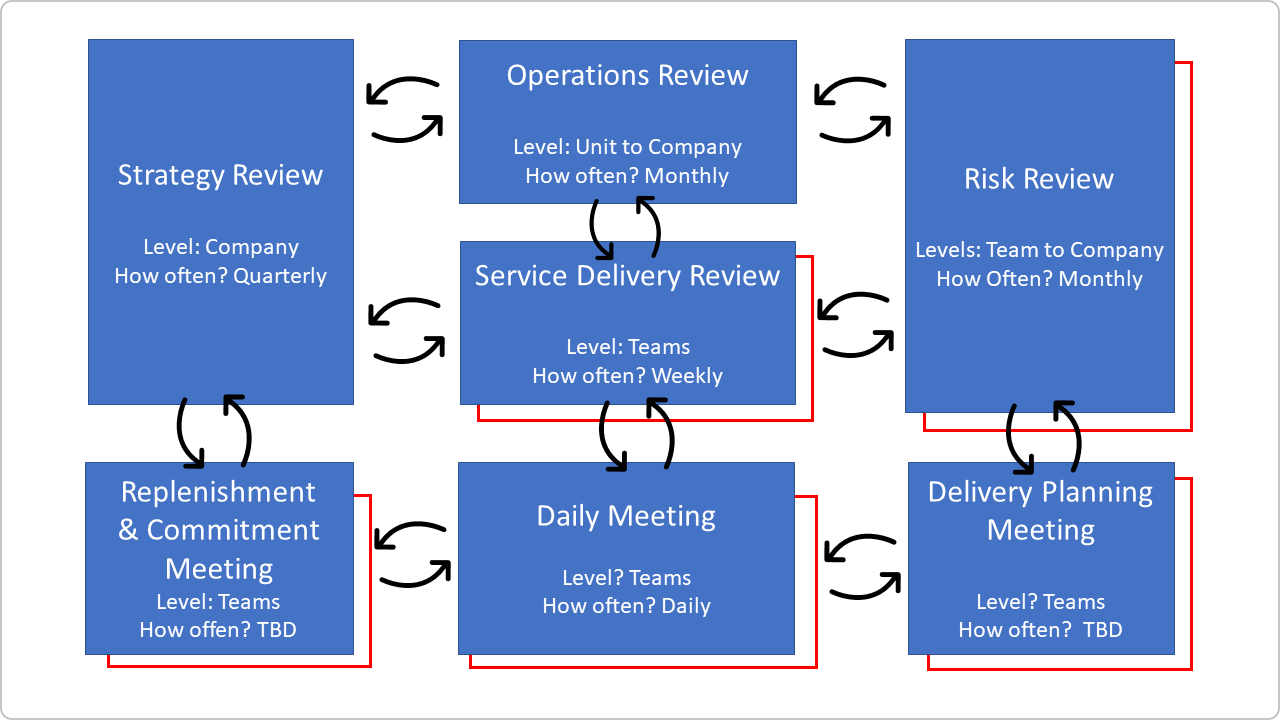Team OKRs refer to objectives and key results set on a team level. If you’re looking to implement OKRs at scale across your organization, they’re an essential part of the equation. With the right OKRs across your teams, you can create a bridge between your high-level goals and the shorter-term ones to align your organizational strategy with team-level targets better.
But what do you need to know to create effective team OKRs and then put them into practice? Keep reading below to learn more.
What Are OKRs?
Before we move forward, if you’re not familiar with the OKR framework, let’s take a quick overview of it. Simply said, OKRs define aspirational goals (objectives) and measurements (key results), which determine whether you’re achieving those goals.
 Image credit: What Matters
Image credit: What Matters
Over the years, the framework has become extremely popular due to its central part in the growth of companies like Google, Intel, Amazon, etc. While implementing OKRs is far from a “walk in the park”, when done correctly, it can help you bridge the strategy-to-execution gap and boost business agility.
There’re different types of OKRs, as organizations usually implement them on a strategic level (company OKRs) and across mid-management or team levels (departmental/team OKRs). You can also have individual OKRs, but we will share why we don’t recommend those. Having said that, let’s begin with what stands behind team OKRs and the difference between the company and team OKRs.
What Is Team OKRs?
Team OKRs provide teams with a direction toward reaching their goals by supporting their effort and keeping the focus on the right priorities. Teams' objectives are high-level goals that should be aligned with the organization's strategic vision. On the other hand, key results should be specific outcomes that tell how far teams are from achieving their goals.
As a result of fostering an OKR culture, teams define their own measurable OKRs, which directly contribute to the organization's strategic vision. In turn, this creates a sense of self-leadership, empowering teams to exceed their goals and move the organization forward. In addition, team OKRs provide teams with the tools to succeed and encourage constant collaboration and learning to improve performance and outcomes.
What Is the Difference between Company OKRs and Team OKRs?
While company OKRs define “broader” strategic objectives, you can think of team OKRs as more actionable and functional goals that each team sets to support the high-level OKRs.
Here’s an example:
| Company/Strategic Objective |
Become a more recognizable solution for finding EV charging stations. |
| Key Result 1 |
Enhance the mobile app with new locations (at least 8). |
| Key Result 2 |
Keep 85%+ user ratings on famous review platforms. |
| Key Result 3 |
Grow mobile app adoption by 60%. |
The Sales team’s OKR could be as follows:
| Sales Team OKR |
Grow quarterly revenue to $700,000. |
| Key Result 1 |
Attract 6 new advertisers on the mobile app. |
| Key Result 2 |
Increase referrals from existing customers to 20% of current revenue. |
| Key Result 3 |
Sign a contract with 2 governmental institutions by the end of Q4. |
Notice how the Sales team OKR is not a direct descendant of the strategic OKR. However, it still supports the high-level goal. For instance, growing the revenue to a specific target means a bigger market share, which translates into the wider popularity of the solution. Another example is the increase of referrals from existing customers by the Sales team, which will impact one of the strategic KRs to grow the mobile app adoption.
In general, rather than cascading OKRs, align the company with team OKRs (and vice versa). This way, teams get more creativity to set their own goals that support the major ones. Ultimately, this benefits the whole organization because when changes occur, teams will have higher agility to adapt to the new business priorities.
The Do’s and Don’ts of Creating Team OKRs
When creating your team OKRs, it’s important to know what to focus on and what to avoid. Let’s see what that may include.
The Do’s When Writing Team OKRs
There are a few things that are considered good practice when creating team OKRs:
-
Setting OKRs should not be done in isolation. It’s most effective when there is a top-down and bottom-up collaboration. So, make sure you engage in regular check-ins with upper management not just to align the team with strategic goals but also to review the progress on current objectives and key results.
-
Don’t forget about your team members who’re closest to the actual work. Once they’re aligned with the overall strategy, they can be a great source of ideas for building the right team OKRs.
-
Make your team OKRs measurable (especially the key results).
The Don’ts When Writing Team OKRs
One of the biggest don’ts is that many teams turn their OKRs into project statements consisting of different activities. This is a pattern that you should avoid if you want to create effective team OKRs. Remember that objectives describe an impact that drives behavioural change, whereas key results are the way to measure how close you’re getting to achieving that impact.
Our next don’t is a subject of many online discussions. It is about whether you should have OKRs on the individual level besides the team level. Keep reading to find out our statement on the topic.
Should You Have OKRs on an Individual Level?
While many companies may decide to implement individual OKRs, we’re listing them as one of our don’ts and here is why.
That’s because you risk creating an invisible competition within your team and harming teamwork. For example, if you prompt a team member to set their own individual OKRs, it’s common that they will comprehend this as performance management. Naturally, this could lead them to set less risky goals and dilute their focus on teamwork.
Obviously, the less risky the goals are, the smaller the impact they will have on the team and the whole organization. Moreover, team members could become less prone to help their peers or share knowledge which is an anti-pattern for having an Agile organization.
So, keep your focus on creating team OKRs that empower team members to work toward a common purpose so they can contribute to the entire organization’s success.
How Two of The Largest Organizations in the World Save Time & Money with OKRs?
How to Structure Team OKRs?
As we’ve gone through some of the best practices for team OKRs, let’s turn our focus on how you can structure them in practice inside your organization. To do that, it’s important to enable transparency within your teams, so everybody can stay aligned on the most important priorities.
Visualize Team OKRs on Team Kanban Boards
If you’re not familiar with Kanban, it’s a workflow management method that emphasizes visualization, limiting work in progress, and data-driven continuous improvement. With the help of interactive Kanban boards, you can put on display all work activities (from initiatives and projects to individual tasks) and track their flow toward completion.
The same thing applies to OKRs across the company, including those on a team/departmental level. The Kanban method is known for its lightweight scalability both vertically and horizontally across the company, especially with today’s digital solutions. Having said that, you can build a network of interconnected Kanban boards for your teams as well as Portfolio Kanban boards for the management level.

Building a network of interconnected Kanban boards can bring work transparency across the whole organization
This allows you to visualize both company and team OKRs in a single place and connect them together. As a result, whenever high-level priorities change, teams will have the transparency to update their course of action promptly too.
Connect Team Goals to Work Progress
While bringing transparency into your team OKRs is important, Kanban boards are an invaluable asset in tracking and optimizing daily work activities. Using them to connect team OKRs with actual work activities (such as projects, tasks, etc.) will give you an overview of how your work progress contributes to achieving the team’s goals.

Connecting team OKRs with team projects/initiatives and individual work items on a Kanban board
Having this information at hand can help you measure your OKRs and engage in continuous improvement discussions with your team members or upper management. For example, comparing work to goals (outcomes) progress might lead to questions such as “Are we working on the right things to achieve our goals?” or "Have we set too aspirational goals or less risky ones"?
 Measuring work and outcomes progress altogether
Measuring work and outcomes progress altogether
In practice, such conversations could happen during regular check-ins, which are an inevitable part of the OKR framework. Luckily, the Kanban method has something to offer in this department too. With the help of the Kanban cadences (which are essentially feedback loops/regular meetings) on different levels in your organization, you can achieve a symbiosis between both team and management levels in the organization. The idea is to build a constant informational flow, foster business agility, and ultimately propel your organizational strategy forward.

Kanban cadences are feedback loops that can be applied across the whole company
Examples of Team OKRs
So far, so good, however, you might wonder what some effective team-level OKRs look like in practice. So, let’s now turn our attention to some OKRs examples below.
| Objective |
Offer a better reporting solution than our main competitors. |
| Key Result 1 |
Gain insights from 7 key accounts who have moved to a competitor or are considering it. |
| Key Result 2 |
Keep Net Promoter Score (NPS) above 65% when releasing new reporting functionalities. |
| Key Result 3 |
Ensure loading time when generating reports is below 4 seconds. |
| Objective |
Release valuable functionalities twice a month to delight our customers. |
| Key Result 1 |
Cut down development cycle time by 30%. |
| Key Result 2 |
Keep monthly product incidents below 5. |
| Key Result 3 |
Reduce quality assurance rejections by 50%. |
- Customer Success/Support OKRs
| Objective |
Ensure data analytics managers are happy with our platform’s performance for their needs. |
| Key Result 1 |
Resolve 90% of tickets from data analytics managers within less than 24 hours. |
| Key Result 2 |
Ensure half of data analytics managers understand how to use our advanced solution 2 weeks after they sign up. |
| Key Result 3 |
Increase service quality rating from 6.5 to 9.0. |
| Objective |
Increase the quality of inbound leads inside the product. |
| Key Result 1 |
Ensure 50% of sign-ups are active users within their trial period. |
| Key Result 2 |
Keep the production of highly targeted case studies with our ideal customer above 3 per quarter. |
| Key Result 3 |
Increase the number of people who sign-up for a product demo by 30%. |
Team OKRs Frequently Asked Questions (FAQs):
What Is Team OKRs?
Team OKRs is a goal-setting framework used by teams/departments to help them to define their objectives and key results. While objectives are specific, measurable, and achievable team goals supporting the organization’s strategic vision, key results measure progress toward achieving the goals.
What Is an Example of Team OKRs?
HR Team OKR example:
Objective: Improve the “remote working” environment and culture.
Key result 1: Increase the number of company-wide events by 30% by the end of the year.
Key result 2: Conduct a survey among remote workers to identify areas for improvement, with at least an 85% participation rate.
Key result 3: Increase the number of 1:1 meetings to 3 per quarter to address issues.
How Do You Write Team OKRs?
Writing Team OKRs is a collaborative process starting by understanding the company’s vision and goals, followed by defining OKRs and writing them down using the well-known formula: We will (Objective - what you want to achieve?) as measured by (Key Results - how are you going to measure our progress?).
Team OKRs must align with the company's strategy and priorities, as this will ensure that the team's efforts contribute to the overall success of the organization.
Measuring the success and monitoring the progress of the OKRs is equally important as structuring them. This can be achieved by making team OKRs transparent and visible for all team members using a visualization tool such as an OKR dashboard. In addition, teams should participate in regular check-in meetings to check the progress against the Key Results and guarantee that the right things are done at the right time.
Businessmap is the most flexible software
to align work with company goals
In Summary
You can propel your organizational strategy through team OKRs, which act as a bridge between organizational/strategic OKRs and execution. Build team OKRs that are measurable, don’t “set and forget” them, and avoid implementing OKRs on an individual level. To structure your team OKRs across the company, focus on:
- Visualizing them on team Kanban boards
- Connecting team OKRs to work activities to measure both goals and work progress
- Engaging in regular check-ins to ensure your teams are working on the right things at the right time.





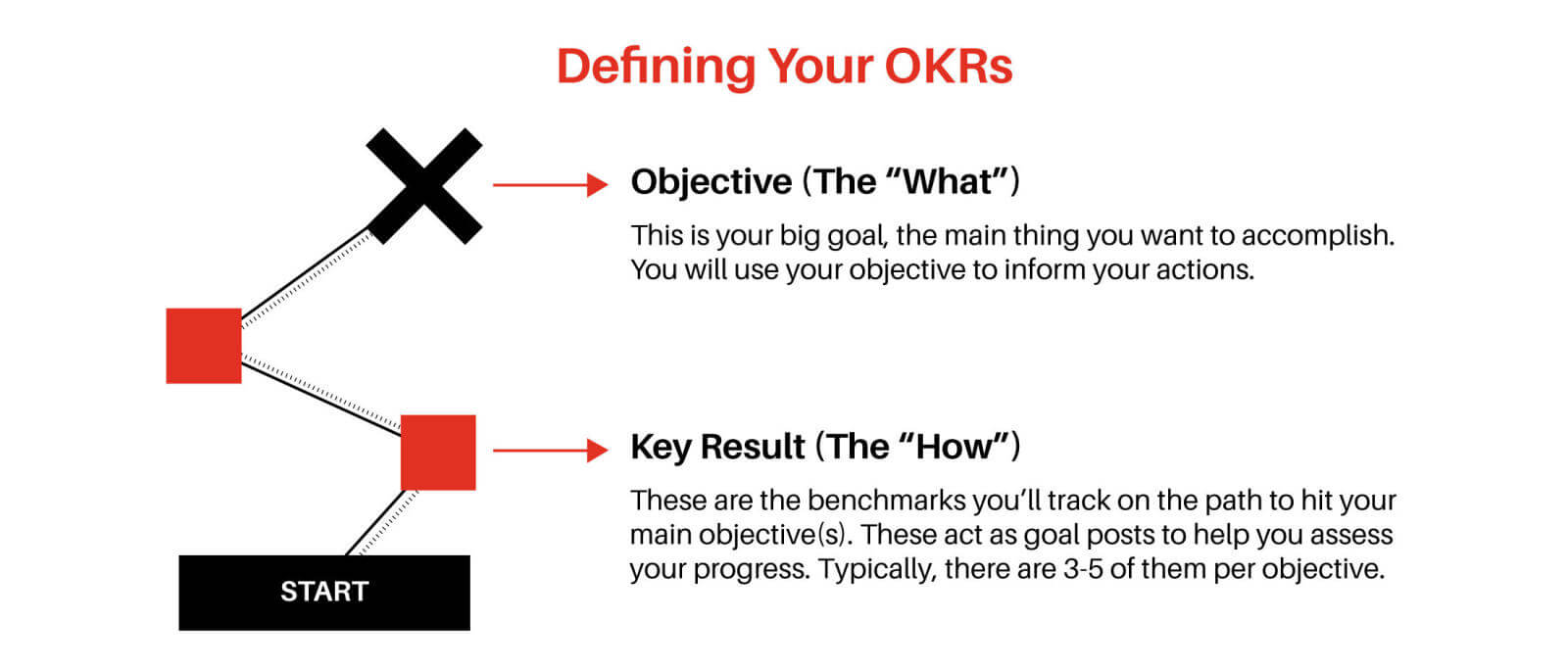 Image credit:
Image credit: 
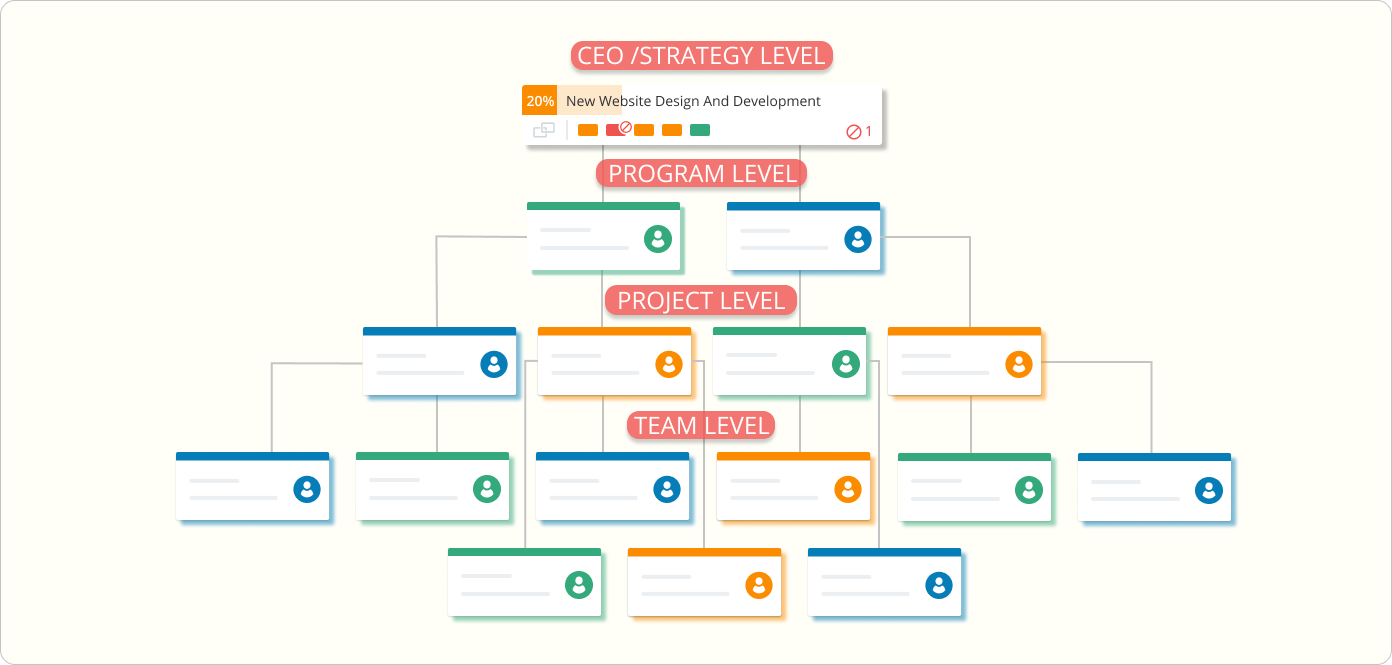
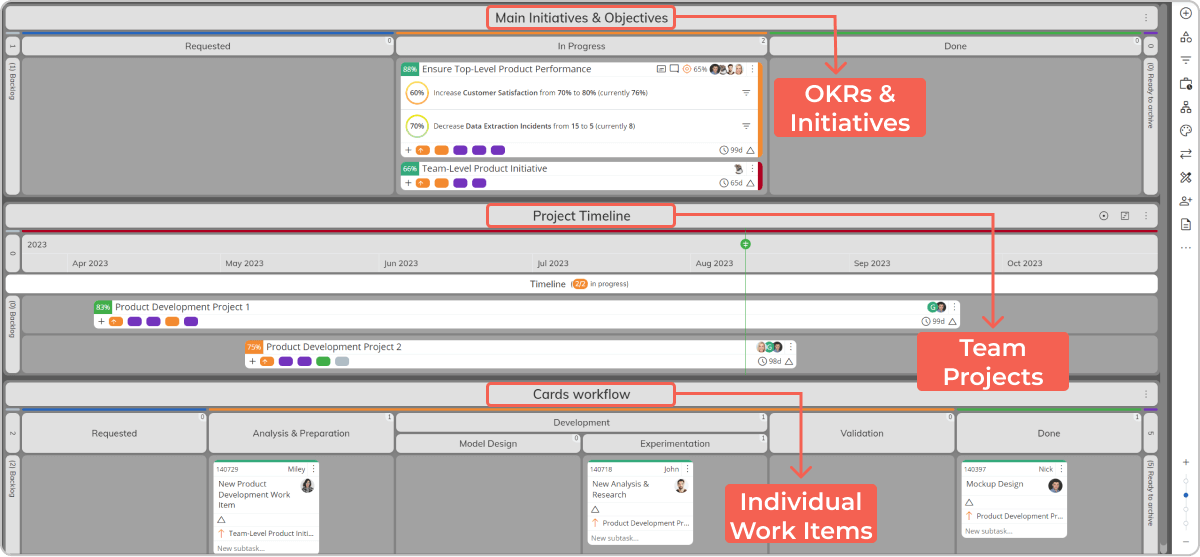
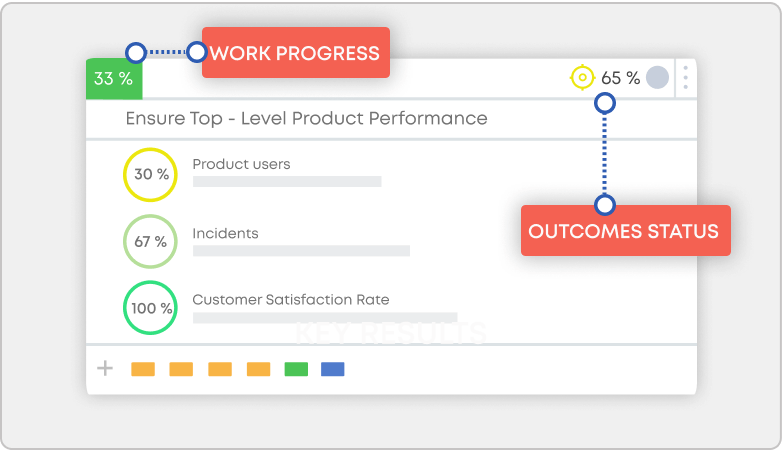 Measuring work and outcomes progress altogether
Measuring work and outcomes progress altogether